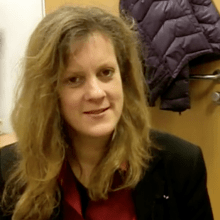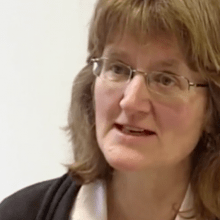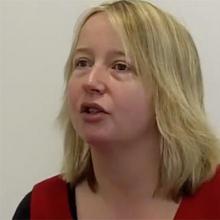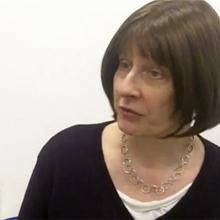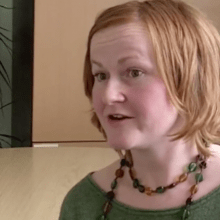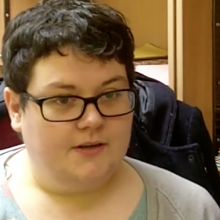Paul Bradshaw gives an overview of the Growing Up in Scotland (GUS) study, which is trying to capture a picture of what life is like for children in Scotland, and the different pathways that children take as they grow up. The study tracks several groups of children through their lives collecting demographic and socioeconomic data, as well as that from 1-1 interviews with parents with the aim of generating a view of the whole child.
Paul describes the findings of the study so far which he suggests are 'unsurprising' from what you would expect, but that paint a starker picture regarding the differences between outcomes for children from different backgrounds.
He notes interesting results, which highlight the differences in cognitive ability between children in high and low income families. At age 3, children from high income families in areas of lower deprivation often out perform their peers. He also notes that these differences appear to be sustained over time, so at age 5, when children are starting school, children from lower income, more deprived areas can be as much as 18 months behind their peers. However the study also looked into factors that can make a difference to this and conclude that home learning activities (such as reading together) can help improve outcomes. These findings contribute to the assertion that preschool age is key for influencing the outcomes of children later on in life.
Paul then highlights how the findings from the study are relevant to policy developments such as the development of the early years framework and also emerging early years legislation.
More information on this research
General information on the study: Growing Up in Scotland
For those particularly interested in finding out more about study results, view the publications page: Growing Up in Scotland - Publications
For further information about the research design, data collection and data content, including accessing the dataset itself and its supporting documentation, please visit the using GUS data page or visit the GUS data page on the UK Data Service website.
Paul Bradshaw
PB: Okay, so the study that I worked on is called 'Growing Up In Scotland' and it's a longitudinal study ... a longitudinal birth and child cohort study. So we are basically covering or tracking several groups of children from their early childhood, into sort of middle childhood, hopefully into adolescence and maybe beyond. It's a study that is funded by Scottish government, funded by the Education Directorate, so a lot of what we do in the study is directed at producing evidence that can be used to inform policy making directly. So at the moment we have 3 groups of children who are involved in the study.
We have what we call our 'birth cohort', our original birth cohort, and there are about 5000 of them - they were born in 2004 and 2005, and we have a slightly smaller group that we call a 'child cohort' who are a wee bit older, and they were all born in 2002 and 2003. And then we have our new 'birth cohort 2', and we have got about 6000 kids in that, and they were all born in 2010 and 2011 - so we have only just started collecting data from that group. But for the other 2 groups we have been tracking them since 2005, and so for the child cohort what we have got now is about 4 years worth of data which covers the period from when they were aged 2 to when they were aged 6. And for the younger group, the birth cohort, we have 6 years worth of data covering from when they were aged 10 months old up to age 6 - so really birth to school entry. And we collect a lot of information on the children involved, mainly through an interview with their parents - so we ask them about their household composition, we ask them about socio-economic characteristics, basic demographic information - but we ask them also a whole host of information about the children themselves, around parenting, around child health and development, around services that they use in relation to the child.
We ask them about physical activity, their neighbourhood and different things like that to build up a picture of the whole child - because this isn't a study that is about child health, it's not a study that is specifically about parenting or specifically about poverty - it's a study that is trying to capture a whole picture of what it's like for children growing up in Scotland and the different pathways that different children take as they are growing up in different areas of Scotland. So the main source of data that we have is, as I say, a face to face interview, but we also collect data from direct measurements. In terms of the findings - you know, we have got such a huge amount of data, and we have analysed quite a lot of it and we have produced annual reports ever since the study launched back in 2005. I think to begin with, a lot of the findings that were coming out from the research - we were often finding ourselves saying "well that's not surprising". You know, we were finding differences between children from more disadvantages circumstances and those with more advantaged circumstances, differences in terms of their health, differences in terms of their diet, differences in sorts of the kind of activities they were involved in. But I think what we did note when we first started looking at the data was that those differences that we expected to see were a bit more stark than we might have expected.
So in particular a lot of the early analysis found that children who were born to particularly young mothers, as compared to those who were born to older mothers, had much more difficult circumstances in which they were being raised, and much poorer outcomes from a much earlier stage. And that difference between the sort of very bottom group and very top group was a lot larger than we might have expected. And I have to say that is something that has featured in the data as we have collected more of it, and these differences do seem to persist to quite a large degree as children move through that early year's period.
Some of the most interesting results we have found so far, as far as I am concerned, as I have said, have been in relation to some of the more objective or standardised instruments that we have used. So in terms of cognitive ability, for example, what we have done there is measure the age 3 children's knowledge of vocabulary, so their expressive vocabulary - their knowledge of words, and their non-verbal reasoning or problem solving ability - and they completed 2 assessments at age 3. So we took that cognitive data and looked at, you know, how children from different types of families fared against each other. And we found that again, as you might expect, children who are in higher income families, those from more educated families, those living in areas of lower deprivation were considerably out-performing ... even at age 3, their peers who were in more difficult family circumstances. But what that initial analysis then did was said "well, you know, not all children from the more disadvantaged circumstances are faring badly, you know, they are not all under-performing, so what are the factors which seem to make a difference to those children?" And one of the key things that came out of that analysis was that activities that involve the child in the home, what we call 'home learning activities', were found to make a difference after you had controlled for those socio-economic characteristics.
So the children in lower income households, the children in more deprived areas whose parents had lower educational qualifications - amongst those groups, the ones who were being read to on a fairly regular basis, who had nursery rhymes, were getting some drawing and painting interaction, those were the ones that were doing better in terms of their cognitive development at age 3. And we extended that analysis when they got to age 5, because we had them complete the same assessments. So we were able to look at a couple of different things - we were able to look at, in the first instance - well does the gap that existed at age 3 still exist at age 5 or has there been any change?
Has the differences between the higher performing groups and lower performing groups reduced in any way or in fact has it extended? And if it has changed, for what children has it changed, you know, and the characteristics of children who have improved on their ability at age 3 relative to other kids? And are there any factors which seem to be particularly helpful for children in the more disadvantaged groups in improving their ability in that pre-school period. Because that pre-school period is key, from a policy point of view, is really important - because pre-school generally, the 0-5 period is considered optimum for influencing children's outcomes.
You know, you get more bang for your buck, more return for the level of investment at that early period than you do at any later period. But also, 95 ... upwards of 95% of children in Scotland attend some sort of statutory pre-school education place. So in terms of government introducing something which might make a difference to improving or reducing that ability gap, you know, there is a key policy opportunity there to do something about it that is already set up and is being exploited by the families that is there to be used by. So we looked at that change, and what we found was that the gap does still exist and it's much the same magnitude as it has been at age 3. So there is not a whole lot of change, and in fact at age 5 it is slightly more worrying, the differences, because you have got children who have started school at age 5, and in terms of vocabulary, children in the lowest education group are around 18 months behind those in the highest education group. So there is evidence of significant delay, vocabulary delay, at the point they are they are starting school amongst children in some groups. But the analysis did show that there were some factors which seemed to help children in the more disadvantaged groups improve on their ability from age 3. So again the home environment was quite important - so children who had a more secure relationship with their parents, children who were read to, this home learning environment had an influence once again. Those were the kids who, relative to their performance to their peers in that disadvantaged group, were doing better during that pre-school period.
So what that analysis suggested was that there are some things that could be done during that 3 - 5 period, that key period when most children in Scotland do start to have some interaction with a sort of reasonably more formal education service that could be built upon to help close the gap at the point of entry to school. The composition of the family is something that we often consider, and we do find differences between couple families and single parent families - but often we found that those differences which appear to exist between couple families and single parent families are more to do with the circumstances in which those families are living - you know, the income that is available, whether or not the parent is employed, the area that they live in - and less to do with simply the fact that there is only one parent in the household.
Also there are quite differentiating aspects of the types of mothers who tend to live on their own, the types of mothers who are in couple families - so they tend to be younger which means that they often don't live in their own house, sometimes they live with their own parents, so the child is in the household with a grandparent, and that can affect caring situations and use of different types of childcare.
A lot of the very recent developments tie in quite closely with a lot of the findings we are producing, so the importance of early intervention, for example, you know we are increasingly finding ... we are starting to analyse outcome data now at age 5 and age 6, so at school entry. But we are increasingly finding that some of the data we have collected at 10 months has an association with what is happening with the child at age 5, with the insinuation therefore that maybe if things are different at 10 months, then they are going to be different at age 5. And quite a lot of the stuff that we have measured at 10 months wouldn't be particularly difficult to change. And there is a sense that that is really impacting now on the very core of Scottish government - you know, we have got a Finance Committee who have just completed an inquiry into preventative spending which is purely about early intervention, about spending money at the early part of the resource to avoid crisis spending.
Yes, something like the Early Years framework embodies a whole sense of government recognising the importance of that period in influencing later outcomes, and I think today ... the Early Years framework has been an excellent idea in principle - I am not sure to what extent we have fully exploited everything that has been committed to in it, but we are getting there. You know, there is talk of Early Years legislation being developed, so our data is going to increasingly have relevance, I would say, particularly over the next year or two as these Early Years issues start coming into the main forum at the centre of policy discussion and legislative discussion.
